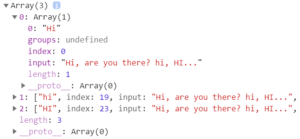

#REGEX JAVASCRIPT CODE#
Regular expressions have many uses in any code which works with text strings (or streaming textual data). This blog entry will cover these search patterns and various ways to use regex within Javascript. Regex (or regexp) are flexible, powerful, and make writing understandable and maintainable programs much easier. Infinite loop while (matchObj = /a+/g.Regular expressions provide the ability to "find" and "find and replace" data through text strings which specify search patterns. lastIndex is always zero and the loop never terminates. For example, in the following while loop, the regular expression is created fresh, every time the condition is checked. Pitfalls of /g and /y # Pitfall: We can’t inline a regular expression with /g or /y #Ī regular expression with /g can’t be inlined. replace() replaces the first occurrence that is found (directly) at. exec() matches multiple times if /y is set (even if /g is not set): > const re = /#/y re.lastIndex = 1 Then they anchor to the beginnings or ends of lines. Note that ^ and $ continue to work as usually: They anchor matches to the beginning or end of the input string, unless. It works as if the beginning of the regular expression were anchored to. lastIndex or later.lastIndex and /y #įor /y. To summarize, for several operations, /g means: Match at. lastIndex and sets it to zero: > const re = /#/g re.lastIndex = 1 lastIndex but does not change it: > const re = /#/g re.lastIndex = 1 lastIndex to remember where it currently is in the input string: > const re = //g lastIndex only has an effect if at least one of the flags /g and /y is used.įor regular expression operations that are affected by it, it controls where matching starts.lastIndex and /g #įor example. matchAll() returns match objects for adjacent matches only: > const re = /#/gy replace() replaces all matches, as long as there are no gaps between them: > '#-#'.replace(/#/gy, 'x') That’s why it only returns two matches in the following example: > const re = /#/gy exec() must immediately follow the previous match. lastIndex, which we’ll get to soon.exec() and /gy # To understand /y on its own, we’ll need to learn about the RegExp property. We will use /y together with /g for now (think “ /g without gaps”). matchAll() only works if /g is set and returns all match objects: > const re = /#/g

replace() replaces all matches: > '#-#'.replace(/#/g, 'x') replace() only replaces the first match: > '#-#'.replace(/#/, 'x')

With /g, it returns one new match per invocation and null when there are no more matches: > const re = /#/g exec() always returns a match object for the first match: > const re = /#/ Let’s see what the multi-match modes look like.exec() and /g # The following two regular expression operations completely ignore /g and /y:Īll other operations are affected by them, in some ways. sticky) is similar to /g, but there can’t be gaps between matches. global) activates multi-match modes for several regular expression operations. These flags can be summarized as follows: Example: Replacing an occurrence at a given index.Example: Finding the location of a match, starting at a given index.Example: Checking if a regular expression matches at a given index.lastIndex: starting matching at a given index Measures for avoiding the pitfalls of /g, /y, and.Pitfall: Code can produce unexpected results if.Pitfall: Adding /g or /y can break code.Pitfall: Removing /g or /y can break code.

#REGEX JAVASCRIPT UPDATE#
Update : Restructured the content to make the introduction easier to understand.


 0 kommentar(er)
0 kommentar(er)
